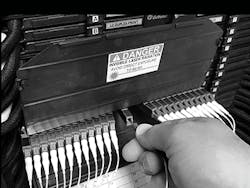6 Challenges/Remedies to Re-Architect Fiber Management at Central Offices & Data Centers:
Over the past 2 decades, the telecom industry has experienced a number of technological and business pivots focused on reducing cost, increasing service velocity, and introducing automation. For instance, active equipment design, application, and realization, have transitioned to a SDN/NFV paradigm using commercial off-the-shelf (COTS) platforms. New fiber cables have been regularly introduced to expedite service delivery while reducing deployment cost.
However, when it comes to Central Office (CO) and Data Center (DC) fiber management solutions, arguably, there have not been many needle-moving innovations for the past 2 decades. This article looks briefly at 6 challenges faced in these situations, and provides potential remedies to them.
Challenge #1
SC (Standard Connector) vs. LC (Lucent Connector) Connectors
Despite its better optical characteristics and performance, for the past 2 decades, mass deployment of LC connectors has been hindered by the well-documented craft operational challenges commonly referred to as the fat-finger issue. A number of products have attempted to address this issue by offering a variety of LC packaging methodologies, such as staggered, but have never fully solved the issue.
A solution is needed where the packaging of LC connectors allows the craft person to access, install, and manage fibers without affecting the adjacent LC ports. The ideal solution would completely resolve the LC connector fat-finger field issue. In this design, each connector would be comfortably handled by technicians with large hands without the risk of impact to adjacent fiber channels. (See Figure 1.) With this approach to LC connector access, a wide variety of packaging configurations can be optimized to deliver the highest possible density of fiber connections in a 1RU chassis. This spreadable connector design also enables a future-proof fiber management system where next-generation even smaller connectors can be handled by field personnel without negatively affecting adjacent connectors. Go!Foton offers this patented spreadable LC connector packaging.
Figure 1. Spreadable LC Connector Resolving fat-finger Field Personnel Operational Challenges.
Challenge #2
Centralized vs. Distributed Fiber Terminations
Traditionally all fibers coming into a CO are spliced in a building entrance vault, and terminated in a centralized fiber distribution panel (FDP) located in a rack or frame. From there, patch cords of various lengths are used to connect to the associated active equipment. This fiber cable patching results in an increased number of connection points (e.g., 3 to 5), thus adding to the overall insertion loss while negatively impacting the optical performance of the fiber channel. This increased number of connection points provides major challenges especially for Metro and ULH transport applications.
With micro trenching, fiber cables for such performance sensitive applications can be grounded at the existing vault (without terminating the fibers) and directly routed to the active equipment frames housing the associated Metro and ULH equipment. The fiber cable can be terminated at that point, thus potentially reducing the number of connection points to 1.
Challenge #3
Frame-Based vs. Chassis-Based FDP
FDPs are traditionally designed to be installed into propriety frames. This results in doubling (e.g., 1 frame for active equipment and an additional frame for the FDP) the space requirements at COs and DCs. This additional space requirement may not have been a serious issue for in-franchise COs where real estate may be abundant. However, with the advent of CRAN (Centralized Radio Access Network) and IoT (Internet of Things) deployments on the horizon, service providers will be providing such services outside of franchise territories. In these scenarios, space is a premium, and taking up real estate for additional frames for FDPs will not be practical. We believe that a 1RU chassis-based FDP is necessary for such out-of-franchise applications.
Challenge #4
FDP Front and Rear Accessibility
The design of FDPs continues to assume and require both front-side and back-side accessibility. This design is valid where space is available and in abundance. For out-of-franchise and congested COs and DCs, a new design paradigm is needed where craft technicians can complete all tasks from the front side of the FDP, and do not require access to the rear of the FDP.
For instance, in 5G/small cell rollout, space requirements are kept at a strict minimum where rear-side access to the FDP will not be practical or available. In cases where rear-side access is provided, the rear access design should also be symmetrical to the front design where all work can be done by field personnel from the rear without having to use the front.
Challenge #5
In-Cassette Passive Optical Component Support
In a number of new service use cases such as NG-PON2, there is a dual requirement for both fiber management and the deployment of passive optical filters (e.g., WM1s). These requirements are usually met with 2 separate products: 1 for fiber management and distribution, and another for housing the passive optical components. This not only increases the real-estate requirements and CapEx, but also measurably increases the OpEx required to patch cord between these 2 units and execute associated maintenance activities.
In addition, some CRAN deployment scenarios require splitters, thus the same challenge exists for this use case. To cut down on labor cost, reduce CO space requirements, and eliminate unnecessary CapEx, a single solution is required where both the fiber management as well as the associated passive optical components can be housed in a single cassette within a single chassis or FDP.
Challenge #6
Proprietary vs. Open FDP
FDPs continue to be a proprietary "box" product — unlike industry progress in introducing open-ecosystem active equipment solutions based on virtualization and COTS. Most of the innovation in our industry has been driven by orchestration of a number of small and large companies directed at co-creating a solution for customers’ challenges. Fiber management products could benefit from such an approach where classes of cassettes/trays from one vendor could fit in the chassis from another vendor. And where chassis from any vendor can fit in any commercially available frames.
We are currently working to initiate an industry working group to start focusing on Fiber Management solution evolution and to provide industry guidelines and recommendations. The goal of this group is to drive innovation in fiber management in concert with new service providers use cases.
Save
Save






